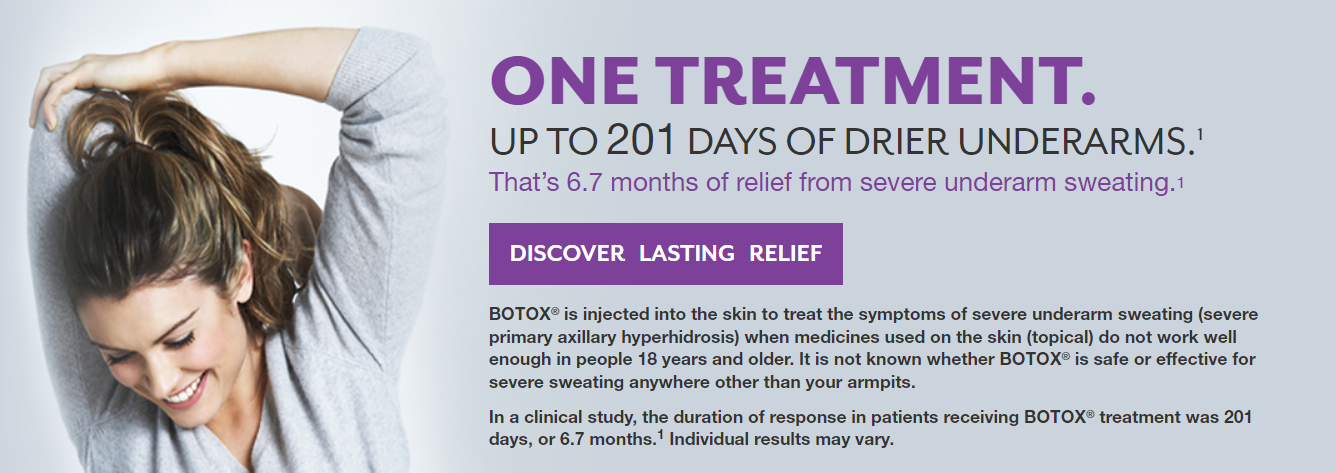
THE SCOOP ON SWEAT - Hyperhidrosis

Sweat is good! (Most of the time)
Sweating is normal and healthy. In fact, your body has between 2 million and 4 million sweat glands.3 When your body heats up, these glands release sweat to help cool you down.
What’s considered “normal” sweating?
There is no “normal”! Some people just naturally sweat more than others, so try not to compare yourself with other people.
Are antiperspirants and deodorants enough?
Not always. Over-the-counter and prescription antiperspirants are 2 of the first options people with severe underarm sweating try.5 These products work by blocking sweat ducts and reducing the amount of perspiration that reaches the skin. Deodorants help control body odor and are typically used in addition to antiperspirants.2 When these products don’t work well enough, it may be time to ask your medical professional about BOTOX®.
Do you sweat “too much”?
If you do any of the following to cope with sweating, talk to your doctor about severe underarm sweating:
- Change your clothes frequently
- Put absorbent materials under clothing
- Avoid certain fabrics or clothing styles
- Seek medical attention and treatment
Are you ready for BOTOX®?
Only you and your medical professional can determine if BOTOX® is right for you. If antiperspirants have failed, talk to your medical professional.
WACO’S MOST TRAINED & EXPERIENCED PROFESSIONALS
The NuGenesis Medical Spa staff are trained professionals who have received extensive training and on-going education for Botox Cosmetic® injections. For a personal consultation on Botox Cosmetic® contact us or call (254) 776-SKIN (7546).


Postmarketing reports indicate that the effects of BOTOX® Cosmetic and all botulinum toxin products may spread from the area of injection to produce symptoms consistent with botulinum toxin effects. These may include asthenia, generalized muscle weakness, diplopia, ptosis, dysphagia, dysphonia, dysarthria, urinary incontinence and breathing difficulties. These symptoms have been reported hours to weeks after injection. Swallowing and breathing difficulties can be life threatening and there have been reports of death. The risk of symptoms is probably greatest in children treated for spasticity but symptoms can also occur in adults treated for spasticity and other conditions, particularly in those patients who have an underlying condition that would predispose them to these symptoms. In unapproved uses, including spasticity in children, and in approved indications, cases of spread of effect have been reported at doses comparable to those used to treat cervical dystonia and upper limb spasticity and at lower doses.
IMPORTANT INFORMATION INDICATIONS
INDICATION
BOTOX® (onabotulinumtoxinA) is a prescription medicine that is injected into the skin to treat the symptoms of severe underarm sweating (severe primary axillary hyperhidrosis) when medicines used on the skin (topical) do not work well enough in people 18 years and older.
It is not known whether BOTOX is safe and effective for severe sweating anywhere other than your armpits.
IMPORTANT SAFETY INFORMATION
BOTOX may cause serious side effects that can be life threatening. Get medical help right away if you have any of these problems any time (hours to weeks) after injection of BOTOX:
- Problems swallowing, speaking, or breathing, due to weakening of associated muscles, can be severe and result in loss of life. You are at the highest risk if these problems are preexisting before injection. Swallowing problems may last for several months.
- Spread of toxin effects. The effect of botulinum toxin may affect areas away from the injection site and cause serious symptoms, including loss of strength and all-over muscle weakness; double vision; blurred vision; drooping eyelids; hoarseness or change or loss of voice; trouble saying words clearly; loss of bladder control; trouble breathing; and trouble swallowing.
There has not been a confirmed serious case of spread of toxin effect away from the injection site when BOTOX has been used at the recommended dose to treat severe underarm sweating.
BOTOX may cause loss of strength or general muscle weakness, vision problems, or dizziness within hours to weeks of receiving BOTOX. If this happens, do not drive a car, operate machinery, or do other dangerous activities.
Do not receive BOTOX if you are allergic to any of the ingredients in BOTOX (see Medication Guide for ingredients); had an allergic reaction to any other botulinum toxin product such as Myobloc® (rimabotulinumtoxinB), Dysport® (abobotulinumtoxinA), or Xeomin® (incobotulinumtoxinA); have a skin infection at the planned injection site.
The dose of BOTOX is not the same as, or comparable to, another botulinum toxin product.
Serious and/or immediate allergic reactions have been reported, including itching; rash; red, itchy welts; wheezing; asthma symptoms; dizziness; or feeling faint. Get medical help right away if you experience symptoms; further injection of BOTOX should be discontinued.
Tell your doctor about all your muscle or nerve conditions, such as ALS or Lou Gehrig’s disease, myasthenia gravis, or Lambert-Eaton syndrome, as you may be at increased risk of serious side effects, including difficulty swallowing and difficulty breathing from typical doses of BOTOX.
Tell your doctor about all your medical conditions, including if you have or have had bleeding problems; have plans to have surgery; had surgery on your face; have weakness of forehead muscles, trouble raising your eyebrows, drooping eyelids, and any other abnormal facial change; are pregnant or plan to become pregnant (it is not known if BOTOX can harm your unborn baby); are breastfeeding or plan to (it is not known if BOTOX passes into breast milk).
Tell your doctor about all the medicines you take, including prescription and over-the-counter medicines, vitamins, and herbal supplements. Using BOTOX with certain other medicines may cause serious side effects. Do not start any new medicines until you have told your doctor that you have received BOTOX in the past.
Tell your doctor if you received any other botulinum toxin product in the last 4 months; have received injections of botulinum toxin such as Myobloc®, Dysport®, or Xeomin® in the past (tell your doctor exactly which product you received); have recently received an antibiotic by injection; take muscle relaxants; take an allergy or cold medicine; take a sleep medicine; take aspirin-like products or blood thinners.
Other side effects of BOTOX include dry mouth; discomfort or pain at the injection site; tiredness; headache; neck pain; eye problems such as double vision, blurred vision, decreased eyesight, drooping eyelids, swelling of your eyelids, and dry eyes; drooping eyebrows; and upper respiratory tract infection.
For more information refer to the Medication Guide or talk with your doctor.
You are encouraged to report negative side effects of prescription drugs to the FDA. Visit www.fda.gov/medwatch or call 1-800-FDA-1088.
Please see BOTOX® full Product Information, including Boxed Warning and Medication Guide, at https://www.rxabbvie.com/pdf/botox_pi.pdf and discuss with your doctor.
If you are having difficulty paying for your medicine, AbbVie may be able to help. Visit AbbVie.com/myAbbVieAssist to learn more.
References: 1. BOTOX® Prescribing Information, August 2022. 2. U.S. National Library of Medicine. National Institutes of Health (NIH). MedlinePlus website. http://www.nlm.nih.gov/medlineplus/ency/article/007259.htm. Updated June 4, 2018. Accessed August 17, 2021. 3. U.S. National Library of Medicine. National Institutes of Health (NIH). MedlinePlus website. http://www.nlm.nih.gov/medlineplus/ency/article/003218.htm. Updated June 4, 2018. Accessed June 25, 2018. 4. Solish N, Bertucci V, Dansereau A, et al. A comprehensive approach to the recognition, diagnosis, and severity-based treatment of focal hyperhidrosis: recommendations of the Canadian Hyperhidrosis Advisory Committee. Dermatol Surg. 2007;33(8):908-923. 5. American Academy of Dermatology (AAD). Hyperhidrosis: Diagnosis and treatment. AAD website. https://aad.org/public/diseases/dry-sweaty-skin/hyperhidrosis. Accessed February 27, 2020. 6. International Hyperhidrosis Society. OnabotulinumtoxinA Injections (BOTOX®). International Hyperhidrosis Society website. http://www.sweathelp.org/en/hyperhidrosis-treatments/botox.html. Updated 2014. Accessed February 27, 2020.



